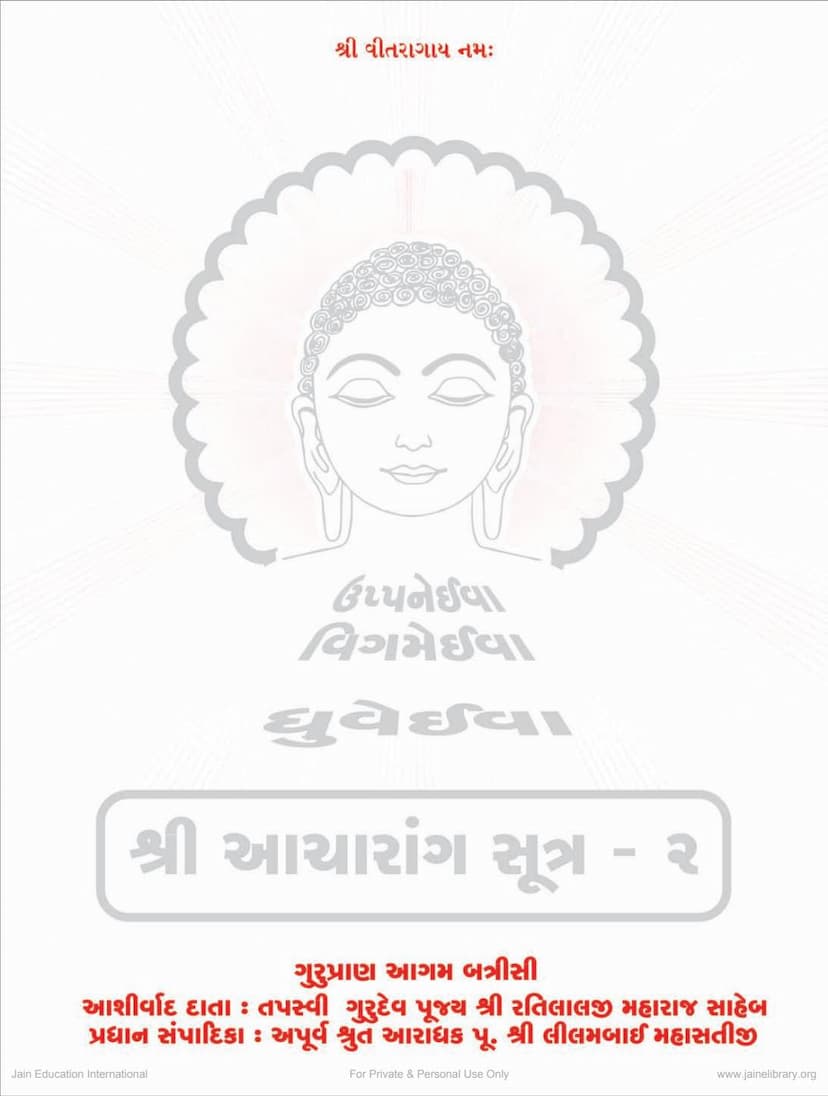Agam 01 Ang 01 Acharanga Sutra Part 02 Sthanakvasi
Added to library: September 1, 2025

Summary
This document is a Gujarati translation of the second part of the Acharyaanga Sutra, which is the first Anga (limb) of the Jain Agamas. Titled Acharanga Sutra Part 2 Sthanakvasi, it is authored by Pushpabai Mahasati, Artibai Mahasati, and Subodhikabai Mahasati, and published by Guru Pran Prakashan, Mumbai. The text elaborates on the principles of Jain conduct and discipline, particularly for ascetics (sadhus and sadhvis), offering detailed guidance on various aspects of their daily life and practices.
Here's a breakdown of the key themes and content based on the provided text:
Core Principles of Jain Asceticism:
The text strongly emphasizes the importance of adhering strictly to the path of Jain spirituality, which is characterized by:
- Non-violence (Ahimsa): The foundational principle of Jainism, permeating all aspects of conduct, from diet to movement.
- Self-control (Sanyam): Mastering the senses and desires through disciplined practices.
- Austerity (Tapas): Engaging in self-purification through various forms of penance and renunciation.
- Righteous Conduct (Achar): The systematic and meticulous following of prescribed rules and guidelines for spiritual progress.
Detailed Guidelines for Ascetic Life (Covered in various chapters/sections):
The Acharyaanga Sutra, particularly its second part, is known for its detailed exposition of ascetic conduct. The text covers numerous aspects of an ascetic's life, detailing what is permissible and what is prohibited. These include:
- Dietary Practices (Aushadha-eshana, Pinda-eshana): Strict rules regarding the acceptance and consumption of food and drink. This involves careful examination of food for any hidden impurities, living beings, or defects, and adhering to specific times and methods for alms-gathering (Bhiksha). The text highlights the importance of accepting food only from pure and well-intentioned households, avoiding food that is prepared with violence or attachment.
- Dwelling and Shelter (Shayya-eshana): Guidelines on selecting appropriate and pure dwelling places (upashrayas), ensuring they are free from living beings and conducive to spiritual practice. This includes rules about how to enter, stay, and maintain the purity of the dwelling.
- Movement and Conduct (Irya-samiti, Vihara): Meticulous rules for walking, moving, and travelling, emphasizing constant mindfulness to avoid harming any living beings (Jiva). This includes specific instructions for navigating various terrains and situations, like crossing water or dealing with potential dangers.
- Speech (Bhasha-samiti): Strictures on speech, advocating for truthful, benevolent, and minimal speech. This involves avoiding harsh, deceptive, or frivolous talk, and speaking only what is necessary and beneficial.
- Personal Belongings (Vastra-eshana, Patra-eshana): Regulations on the number, type, and condition of clothing (vastra) and utensils (patra) an ascetic can possess. These items must be obtained with utmost care, free from any defects or violence.
- Interaction with the World: Guidance on interacting with laypeople (grihasthas), avoiding attachment, and maintaining an attitude of detachment and equanimity. Specific rules are given for entering households, accepting alms, and interacting with different individuals.
- Renunciation and Detachment: The text emphasizes the importance of renouncing all worldly possessions, attachments, and desires, including even the body's comforts and the mind's inclinations, to achieve spiritual liberation.
- Purity of Intent and Action: Every action, no matter how small, must be performed with pure intention and strict adherence to Jain principles, particularly non-violence.
Key Concepts Elaborated:
- "Agra-pinda" (first morsal): The concept of taking the first part of the food with utmost care and offering it with pure intention.
- "Avagraha": The principle of seeking permission or taking permission before entering any place or using any object. This is crucial for avoiding inadvertent harm to living beings and respecting the property of others.
- "Upasarga" and "Parishaha": The text implicitly or explicitly discusses enduring hardships and afflictions with equanimity, as prescribed by Jain asceticism.
- "Bhavana" (Meditation/Contemplation): The text outlines various Bhavanas that ascetics should cultivate, such as reflecting on impermanence, suffering, and the path to liberation.
Specific Examples of Conduct:
The text provides specific examples of conduct in various situations, such as:
- Rules for accepting food from households that may be considered impure or flawed.
- Guidance on how to interact with other ascetics, including senior monks and those from different sects.
- Instructions on proper conduct when dealing with animals, potential dangers on the path, or uncooperative householders.
- Detailed explanations on the purity of utensils and clothing, and the rules for their use and maintenance.
- The importance of maintaining equanimity and detachment in all circumstances, whether favorable or unfavorable.
Spiritual Significance:
The Acharyaanga Sutra is considered fundamental in Jainism as it lays down the very foundation of an ascetic's spiritual path. By meticulously following these guidelines, ascetics aim to purify their conduct, eradicate karmas, and progress towards liberation (Moksha). The text highlights that the external actions are a reflection of the internal spiritual state, and true austerity lies in the diligent and mindful application of these principles in every moment of life.
Overall, the Acharyaanga Sutra Part 2 is a comprehensive guide to the rigorous and disciplined life of a Jain ascetic, emphasizing purity of conduct, mindfulness in all actions, and unwavering devotion to the principles of Jainism as a path to spiritual liberation.